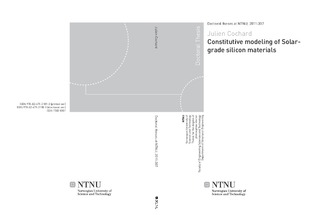| dc.contributor.author | Cochard, Julien | nb_NO |
| dc.date.accessioned | 2014-12-19T12:00:06Z | |
| dc.date.available | 2014-12-19T12:00:06Z | |
| dc.date.created | 2012-05-29 | nb_NO |
| dc.date.issued | 2011 | nb_NO |
| dc.identifier | 529161 | nb_NO |
| dc.identifier.isbn | 978-82-471-3189-3 | nb_NO |
| dc.identifier.uri | http://hdl.handle.net/11250/236910 | |
| dc.description.abstract | Residual stresses in directionally solidified silicon ingots are known to increase the likelihood of material failure, leading to unnecessary costs and material waste. These stresses develop during solidification and cooling, owing to thermal gradients, the multicrystalline nature of the materials, and its impurity content.
Silicon multicrystals (mc-Si) are simply aggregates of several, rather large single crystals. Hence, building a model for mc-Si consists in the development of accurate constitutive equations for SoG-Si monocrystals and the construction of multicrystalline aggregates by Finite Element methods.
Constitutive models for solar-grade silicon monocrystals (SoG c-Si) of various complexity are derived in this thesis. Their ultimate goal is to allow the quantification of the residual stresses in SoG-Si materials given a thermomechanical loading path.
A physical approach to modeling plasticity in semiconductors has been consistently adopted: all equations are based on the introduction of dislocation densities, carrying plastic flow and participating to material hardening with deformation. Constitutive equations are implemented into a rate-dependent crystal plasticity kinematical framework.
The benefits of this methodology are twofold: firstly, the models are perfectly useable in the temperature range where silicon behaves as a perfectly elastic material, but they excel at reproducing its particularly temperature-sensitive plastic behavior. Secondly, final dislocation densities can be predicted by the models. These are of great use for industrial applications, since regions of large dislocation contents also exhibit poor electrical performance.
Consequently, the constitutive models introduced in this Ph.D. thesis are not limited to stress calculations, but can be coupled to other physical analyses.
An exhaustive literature review has been written, covering the aspects of plastic deformation over multiple scales. It lays the foundation for analysis and improvement of existing constitutive models. Systematic identification of constitutive parameters of traditional models calls for the introduction of new internal variables, dislocations stored in dipolar structures. Accounting for these immobile dislocations enables an extension of the model of Alexander & Haasen to correctly reproduce the steady-state of deformation during uniaxial testing of silicon monocrystals oriented for single glide.
The influence of dissolved oxygen on the plastic behavior of silicon monocrystals is successfully reproduced by the introduction of an effective density of mobile dislocations. This model for extrinsic materials can be generalized to other impurity types, provided physical parameters related to their diffusivity and dislocation locking effect are known.
Shortcomings of this extension are solved by deriving a completely new constitutive model, arguably the most accurate one available for study of covalent materials. The potentially rate-limiting dislocation motion mechanisms of jog dragging and pinning by localized obstacles are introduced in the velocity law. Dislocation populations are segmented by their character and potential mobility. An accurate dislocation multiplication law for the yield region of silicon monocrystals is introduced. The model is shown to reproduce correctly the experimentally observed steady-state of deformation, stress overshoot, and strong linear hardening rate in stage II.
The experimentally characterized flexural strength of SoG mc-Si bars can be used in the constitutive models to output the fracture probability of silicon.
Application of the extended AH model to bending cases of intrinsic and extrinsic mono- and multicrystals, to tension of a multicrystal containing hard SiC inclusions and to directional solidification of an intrinsic mc-Si ingot provide valuable information about the magnitude and various length scales over which stress heterogeneities develop in impure mc-Si materials.
Finally, some guidelines for future work are given, both on practical and theoretical aspects. | nb_NO |
| dc.language | eng | nb_NO |
| dc.publisher | Norges teknisk-naturvitenskapelige universitet, Fakultet for ingeniørvitenskap og teknologi, Institutt for konstruksjonsteknikk | nb_NO |
| dc.relation.ispartofseries | Doktoravhandlinger ved NTNU, 1503-8181; 2011:307 | nb_NO |
| dc.title | Constitutive modeling of Solargrade silicon materials | nb_NO |
| dc.type | Doctoral thesis | nb_NO |
| dc.contributor.department | Norges teknisk-naturvitenskapelige universitet, Fakultet for ingeniørvitenskap og teknologi, Institutt for konstruksjonsteknikk | nb_NO |
| dc.description.degree | PhD i konstruksjonsteknikk | nb_NO |
| dc.description.degree | PhD in Structural Engineering | en_GB |
